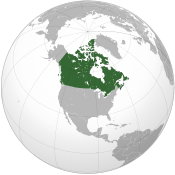Canada keeping eye on Deepwater Horizon spill
Sunday, May 30, 2010
The Canadian Government is watching the "slowing growth" of the BP oil spill.
Canada is running their dash-8 on a twice a day mission to the gulf, monitoring for signs that the BP Oil slick may expand up the Eastern seaboard into Canadian waters, and to provide assistance to US efforts to contain the spill. This started in May, and is expected to continue until the spill has been fully contained, or no longer needed. Canada has also provided technical experts, research and development teams, and general staffing to assist in spill containment and cleanup.
While the risk is slim that the oil slick will move up the seaboard enough to get into Canadian waters, it is possible. Currently the spill is being held within the Gulf of Mexico, however, as the spill grows each day it is at bigger risk of being picked up by the Loop Current.
"If oil is swept up into the Loop Current—which moves at about 3.3 to 6.5 feet (one to two meters) a second—there's essentially no way to stop it," Tony Sturges, professor emeritus of oceanography at Florida State University, told National Geographic. "Once [oil] gets into the loop current, you can bet the farm it will go around to the south"
After being picked up by the Loop Current, the oil spill could then quickly be carried further by the Gulf Stream, which can travel up to 2.5 metres per second (5.6 mph). This current leads right through some of Canada's best fishing waters, and could potentially even be washed up directly onto the shores of Canada, if not properly contained.
This spill could devastate the fishing industry of Canada, and harm any potential tourism on the beautiful coastal waters of Eastern Canada. So while Canada is offering its hand to the United States as a gesture of assistance, it serves dually as a self assurance that Canada will not be affected by the spill, and to stop it before it reaches the border if it does get picked up by the currents.
 | |
| Credit: Transport Canada | |
| Transport Canada's dash-8 that is currently flying two runs a day over the gulf to track expansion, and collect data on the BP oil spill. | |
 | |
| Credit: Kmhkmh | |
| Image showing how the Loop Current cycles within the Gulf of Mexico. | |
 | |
| Credit: RedAndr | |
| If the oil slick can make it to the gulf stream, the incredibly fast current can quickly take the oil slick up into Canadian waters. | |
Sources
- Thomas Walkom. "Walkom: Threat of oil spill disaster worse in Canada" — The Star, May 29, 2010
- Chris Graham. "The Gulf Oil Spill: A Virginia Perspective" — AFPTheMagazine, May 28, 2010
- Christine Dell'Amore. "Gulf Oil Spill Could Reach East Coast Beaches" — National Geographic, May 4, 2010
- Paul Hunter. "Transport Canada helps track Gulf oil spill" — CBC News, May 11, 2010



